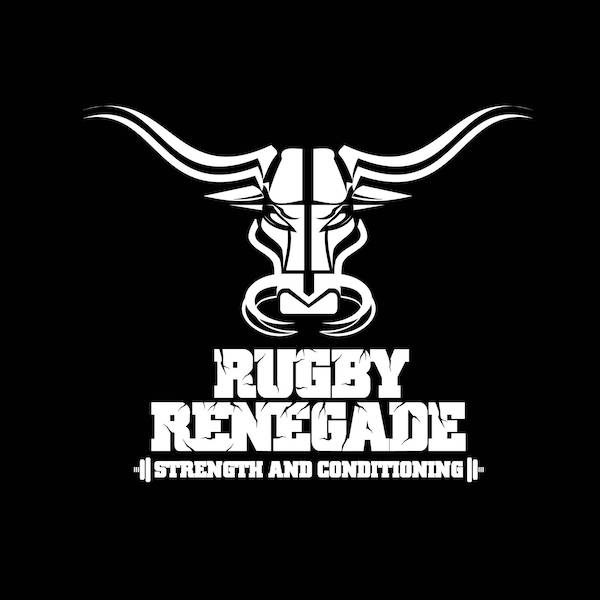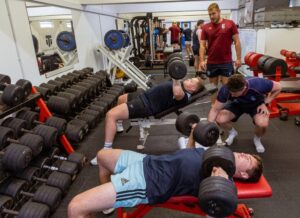The force-velocity curve is one of the most important concepts to understand when aiming to increase performance on the rugby pitch. In this article we discuss the force-velocity curve in detail…
Rugby Strength and Conditioning: The Force Velocity Curve
One of the goals of a strength programme for rugby players should be to shift the curve to the right. A shift, means that the rugby player can apply greater force at higher velocities, allowing him to run faster, tackle harder and break tackles.


It is important that a shift in the force-velocity curve to the right (Zatsiorsky 2006) occurs because in sport, speed kills. The problem is that adaptations to training are specific in nature. Graph below shows what happens to the force velocity-curve after strength training (blue line) and speed training (green line). In advanced rugby players, if you train at one end of the force velocity curve, you will improve that part of the curve, but the other will decrease.

The force-velocity curve can be broken down into five different areas —maximal strength, strength-speed, power, speed-strength, and speed. For rugby players, improving their strength levels will help shift the curve to the right, as strength is the quality that affects all other qualities. Traditional linear periodisation aims to hit each part of the curve in different blocks. For example, a rugby player usually in the off season or preseason would spend four weeks on hypertrophy, then on strength, then on maximal strength, and then on power/speed/explosiveness. While there are many great things about linear periodisation, the concept of focusing on just one quality at a time might not be the best or most efficient when you have a relatively short time span and want the most bang for your buck. In rugby, power and speed are two of the most important qualities. If you only have a t12 week off/pre season for which to focus on training, do you really only want to spend four to eight weeks focusing on your most important qualities?

When trying to improve on field rugby performance, hitting multiple points on the force-velocity curve will help shift a rugby players curve to the right. Using a modified conjugate system allows for multiple points on the curve to be targeted at the same time. One day targets strength-speed/power, another targets speed/speed-strength, and another targets maximal type strength. Using different types of exercises and loads within each given spectrum allows for different parts of the curve to be sub-targeted.

Speed-Strength – 30-60% 1RM (Evasive Running, Making a Break, Support Play)/1.0-1.5 m/s
This day is solely about velocity of movement—plyometrics, speed work (both linear and lateral), and agility. It works well when you continually progress your exercises. So, for example, do squat jumps for a couple weeks and then move to repeat squat jumps, box jumps, hurdle hops, hurdle hops to broad jumps, and so on. While velocity is still important, you can add things in that influence the amount of force and velocity that are being realized. Doing sled sprints with 10–15 percent of an athlete’s body weight and performing jumps with some sort of relatively light resistance (vertimax, dumbbells, weight vest, barbell) and single-leg plyometrics will all require more force while giving up some velocity.
Strength-Speed – 70-80% 1RM (Rucking, Tackling, Breaking a Tackle)/0.75-1.0 m/s
Most traditional dynamic effort lifting is done at around 60 percent. Even smaller percentages are used when the individual becomes more experienced and stronger. Working at around 60 percent doesn’t elicit a great enough stimulus for most rugby players, as their nervous systems aren’t proficient enough. Instead, working at around 70–80 percent on the dynamic day and performing five to eight sets of two to three reps forces the athletes to use the full power of their nervous systems and musculature to move the weight as fast as possible. That’s the single goal—to move the weight as fast as possible. Plyometrics or short sprints can be combined with the main lift to target the velocity portion of the curve. There are different ways to add a new stimulus to this day by changing the percentages used, waving the percentages, and changing the exercise. Back squats, front squats, and deadlift variations all work well.
Maximal Strength – 85-95% 1RM (Scrummaging, Wrestling for the Ball)/0.15-0.35 m/s
Generally, work at 85–95 percent doing two to four reps. In Season there is no need for rugby players to perform true one-rep maxes every week. With less experienced lifters, the chances of an injury occurring are increased, and the rugby players can tend to miss their depth on squats. There are some valid arguments to be made about using maximal strength in season. There is no need to take the chance of increasing the likelihood of injury, which would mean the player couldn’t play or train.
With that being said though, working up to two- to five-rep maxes, followed by possibly a jump variation. Performing lifts under heavy loads is one of the best things a rugby player can be put through, as it requires a great deal of mental focus, mental toughness, and competitive drive, all of which are necessary to succeed not just on the playing field but also in life. Back squats, front squats, and deadlifts variations work well. This point often is completely overlooked, the mental preparation is just as, if not more so, than the physical preparation.




